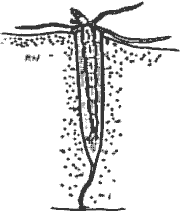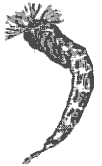 CHIRONOMID CHIRONOMID
article
by Ron Newman
Scientific
Name:
- Class-Insecta,
Order-Diptera, Family-Chironomidae. (Over 2000 species)
Common
Names:
General
- Small
two-winged flies in the adult stage. Closely related to mosquitoes and
Chaoborus (Phantom Midge or Glassworm). However, mosquitoes do not normally
live in our lakes due to wave action and Chironomid do not bite like
mosquitoes. Due to their similarity, the Chaoborus will be included
in this discussion.
Life Cycle:
- Adults
swarm and mate in flight. Most lay eggs singularly or in strings while
skimming over the water surface. Some species lay eggs directly on vegetation
or bottom substrates. The eggs hatch into larva and form mud tubes from
bottom material and mucous. A few species have free swimming larva such
as the Bloodworm and Glassworm. The larva grow and develop into the
pupa stage. When fully developed, the pupa wiggle their way to the lake
surface. It often takes several minutes for the pupa to get through
the "surface tension" of the water before it can hatch. The process
of breaking open the pupal skin, the adult crawling out, drying its
wings, and flying away is usually accomplished in less than a minute.
Once hatched, the adults may live from a few hours to a couple of months
before mating and dying.
Appearance:
- The larva
have segmented bodies, are worm-like and look much like a long skinny
grub or maggot. This appearance gradually changes as they develop into
a pupa. The pupa develop an eye-spot and wing casing and most notably
have feathery white gills near the head. The head and wing casing are
usually one quarter to one third of the body length and the abdoman
has 7 or 8 body seqments. Adults look like a mosquito with feathery
antenna.
Size:
- Pupa are
up to 20 mm long ( ¾ inch) but average about 8 to 15 mm ( ¼ to ½ inch).
Colour:
- The pupa
tend to be black, brown, reddish-brown or green but can come in a variety
of other colors. Larva tend to be cream colored or may have a greenish
tinge. There is a type of free swimming Chironomid larva that stores
oxygen in it's blood and is thus blood red in color (Bloodworm). A free
swimming larva of the Chaoborus family is virtually transparent (Glassworm).
Movement:
- Free swimming
larva like the bloodworm, do just that. They crawl, float or swim around
the lake but generally tend to hide under rocks or rotting logs and
remain fairly immobile. Most larva build and stay inside a mud tube
on the lake bottom and don't move very far from that. When the larva
develop into pupa they leave their mud tubes or hiding places, fill
air sacks within their skin for buoyancy, and slowly wiggle their way
to the surface to hatch. Often during this process they are stationary,
suspended between lake bottom and surface. As adults, Chironomid fly
over the water surface laying eggs and sometimes land on the water surface.
Habitat:
- As long
as they can get a food supply, Chironomid larva will live in almost
any type of water. Clear or polluted with bottoms that are muddy, rocky,
weedy or sandy doesn't seem to matter. However, their food source is
generally most abundant on or near shoals and this is where their numbers
peak. The preferred food seems to be Blue-Green Algae. The fecal pellets
of Chironomid which have been feeding on Blue-Green Algae is the major
component of 'Marl Shoals'. These are very similar to the oil forming
shales. The adult and pupa of the Chironomid don't feed.
 Importance
to Fly Fishing Importance
to Fly Fishing
- After
freshwater shrimp, Chironomid are the next most important food source
for the Kamloops Trout. Throughout the fly fishing season, daytime feeding
samples show that 27% of the trout's daytime feeding consists of Chironomid.
This drops to 14% for those fish feeding in the evening or at night.
- Of importance
is the fact that Chironomid are much more significant as a daytime food
source. I suspect the 14% for the evening to night samples is a bit
high. Some of those samples have probably included fish that were also
feeding during the daytime.
Larva:
- In their
larval stage, only the free swimming larva (Bloodworm and Glassworm)
are normally found in the feeding samples of the rainbow trout. Most
other larva tend to stay in their mud tubes on the lake bottom and thus
are of little importance for imitating with flies. Due to it's transparancy,
the Glassworm is almost impossible to imitate with a fly and thus looses
importance. However, Bloodworms total to 3% of the trout's diet and
shouldn't be ignored. Retrieve the Bloodworms much the same as you would
a Chironomid pupa and in the same types of water.
 Pupa: Pupa:
- Chironomid
in the pupal stage are at their most important point of development
for the fly fisher. When leaving the bottom of the lake and traveling
to the surface to hatch, they are most vulnerable to predation by the
trout. Even the largest trout will actively feed on these pupa and they
are successfully fished throughout the year.
- Chironomid
pupa should be fished on a dry line and the flies should be weighted.
The retrieve should be very, very slow or even still. Vary your leader
length to achieve the desired depth for the fly. The pupa can be found
at most any depth in the lake but the trout will feed on these more
actively on the shoals and drop offs. The colour and size of the fly
seem to be more important than whether the flies have ribbing or gills.
Flies with or without the gills and/or ribbing seem to work equally
well.
- Here is
a hint that most fly fishers haven't yet picked up on when tying flies
to imitate the Chironomid pupa. Make the bend and point of the hook
appear as the tapering abdomen and tail part of the pupa rather than
something the pupa is attached to. It will look like the pupa is in
the curled position for wiggling to the surface. This is one of the
few flies on which you can totally camouflage the hook.
 Adults: Adults:
- Chironomid
adults, or when they are emerging into adults, are taken throughout
the year by the rainbow trout. Most any of the very small dry flies
will do as an imitation. Although taken by the trout, the adult Chironomid
is taken much more actively by the smaller fish than the larger fish.
When presenting the adult, try to get an 'S' shape in your leader (or
even an arc) and retrieve with a long, slow, steady pull to imitate
an adult skimming the surface laying eggs. Letting the fly just sit
on the surface also works. For an emerging Chironomid, try tying an
un-weighted pupa but where the gills would normally be tied, insert
a clump of deer hair (or other lighter coloured floating material) of
about two-thirds the pupa length.
Hatches:
- Various
species of Chironomid hatch whenever there is water free of ice. Seasonal
peaks occur from the third week in May to the second week in June and
then steadily decline into the fall months. However, very large hatches
of individual species can occur at most any time of the year. Chironomid
larva on the lake bottom will sometimes exceed 50,000 individuals per
square metre and thus form 'major' hatches. . If you are fishing in
a 'major' hatch, use a fly that is slightly larger than the actual size
of the pupa. For the fly fisher, minor hatches often result in more
fish than a major hatch. Hatches usually occur during the daylight hours
but various species will hatch at night.
Recommended
Fly Patterns:
- Larva:
- Pupa:
- Little
Black Chironomid
- Red
Butt
- Tunkwanamid
- Moosemane
- Red
Chironomid
- PKCK
- Hatheume
- Emerging
Chironomid
- Adult:
- Lady
McConnell
- H.C.H.
- Humpy
- Mosquito
Be
sure to read other articles by Ron Newman
Study
Other Insects
| Tip & Techniques
| Study Fly Patterns
|



 CHIRONOMID
CHIRONOMID Importance
to Fly Fishing
Importance
to Fly Fishing Pupa:
Pupa:
 Adults:
Adults: